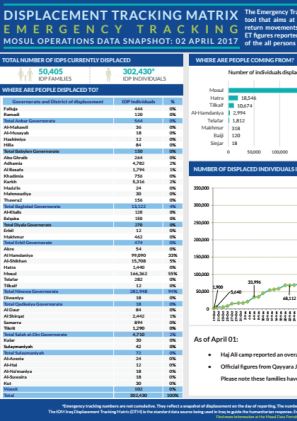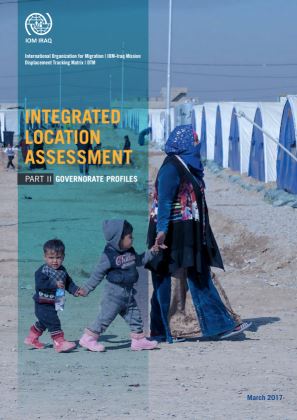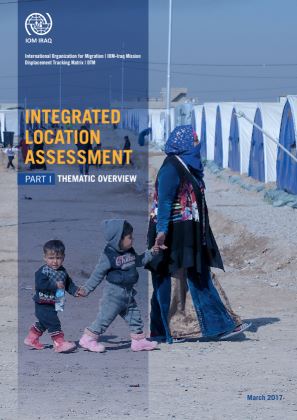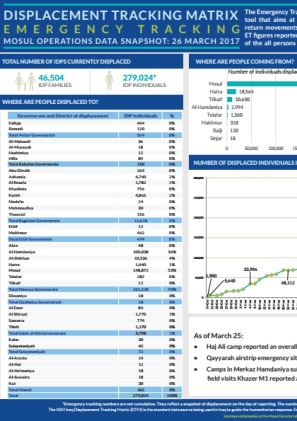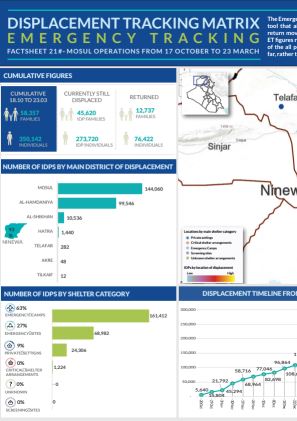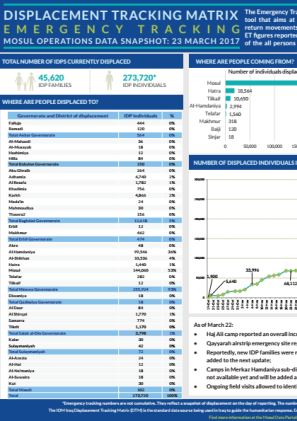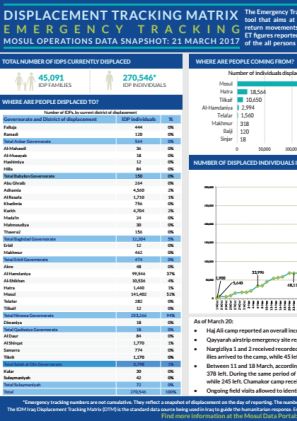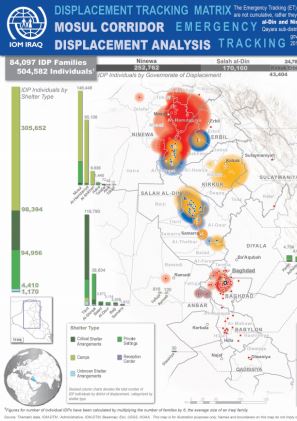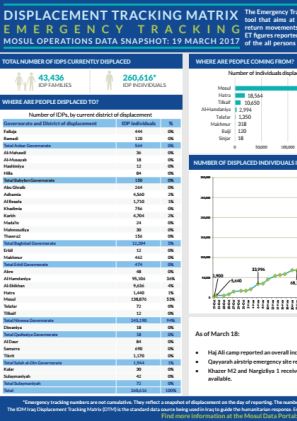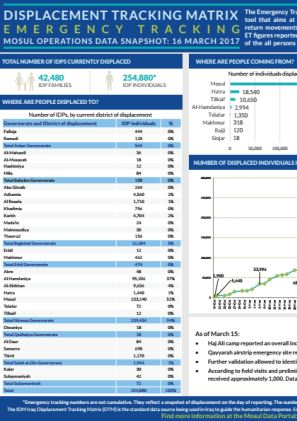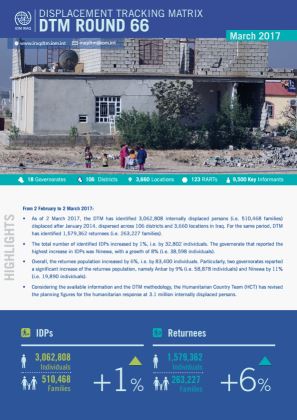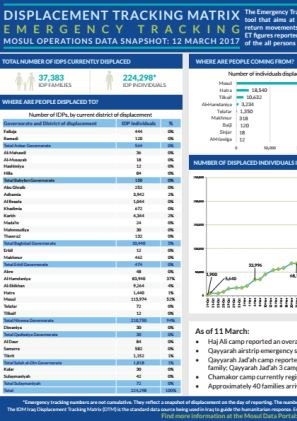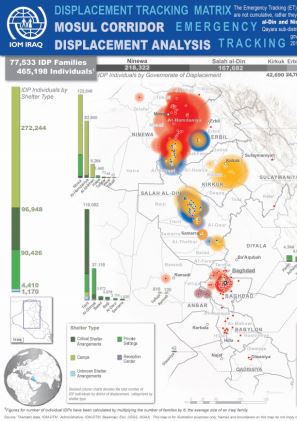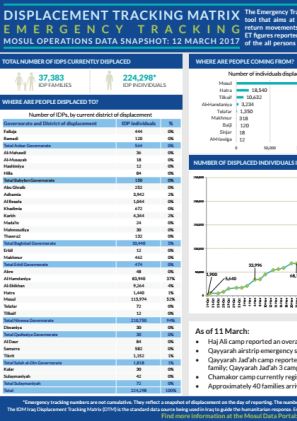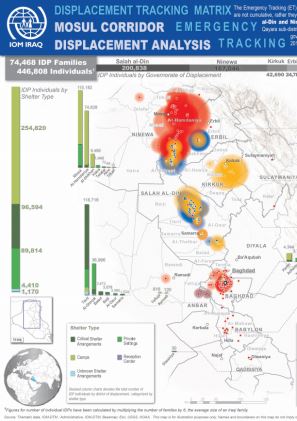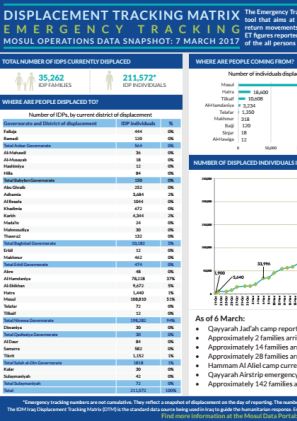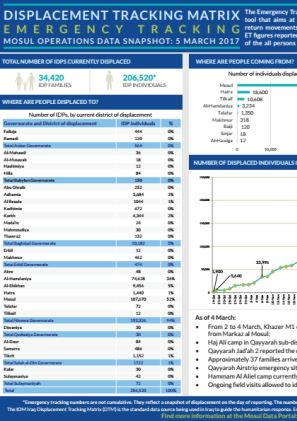-
Countries
-
Data and Analysis
-
Special Focus
-
Crisis Responses
Iraq
IDPs tracked
Displacement Movements
1,124,000
IDMC 2023
Data collection round
About Iraq
Reinforced in January 2014 in response to the need for information on displacement linked to the worsening armed conflict, the DTM programme in Iraq collects key information on internally displaced persons (IDPs) and returnees through different components and methodologies across the entire country.
Through IOM's Rapid Assessment and Response Teams (RARTs) -composed of 140 field staff- present throughout the Iraqi territory, the DTM collects data on numbers and locations of IDPs and returnees using an extended network of over 4,000 key informants. In addition to information collected from key informants, identified locations hosting IDPs are then visited and directly assessed by the RARTs to collect more detailed and in-depth information on the displaced population.
Please visit the Access to Durable Solutions among IDPs in Iraq
Iraq — Mosul Operations Data Snapshot (2 April 2017)
DTM recorded 302,430 IDPs comprising 50,405 families across ten governorates. The governorate of Ninewa currently hosts the most IDPs, 282,984 (94% of the total). Mosul was the most commonly cited district of origin with 267,948 people recorded as originating from there.
Iraq — Integrated Location Assessment Part 2 (March 2017)
The Governorate Profiles complement Part I (Thematic Overview) providing individual profiles of the eighteen Iraqi governorates, thus reviewing all key themes identified at governorate and district level.
Iraq — Integrated Location Assessment Part 1 (March 2017)
As of December 2016, there were 3,064,1462 IDPs displaced due to conflict in Iraq, living in 3,700 locations across the country.
Iraq — Mosul Operations Data Snapshot (30 March 2017)
47,875 Families comprised of 287,250 IDPs were recorded. Most IDPs originated from Mosul (252,768 individuals) and most IDPs were living in camps or emergency sites (244,404 individuals).
Iraq — Emergency Tracking Factsheet 22 (30 March 2017)
DTM recorded 47,875 families comprised of 287,250 individuals. The district hosting the most IDPs is Mosul (151,182 IDPs). 13,438 families (80,628 individuals) were recorded as returnees.
Iraq — Mosul Operations Data Snapshot (28 March 2017)
DTM recorded 47,670 IDP families comprised of 286,020 individuals. The governorate hosting the largest number of IDPs was Ninewa where 266,808 IDPS were recorded. The most commonly reported district of origin amongst IDPs was Mosul with 251,544 IDPs coming from there.
Iraq — Mosul Operations Data Snapshot (26 March 2017)
DTM recorded 46,504 IDP families comprised of 279,024 individuals. The governorate hosting the largest number of IDPs was Ninewa where 261,228 IDPS were recorded, this represents 94% of the total.
Iraq — Emergency Tracking Factsheet 21 (23 March 2017)
The cumulative total of IDPs recorded by DTM during this period was 350,142 individuals comprising 58,357 families. Of these 273,720 individuals (comprising 45,620 families) are still displaced. 161,412 people are currently residing in emergency camps.
Iraq — Mosul Operations Data Snapshot (23 March 2017)
DTM recorded 273,720 IDPs comprising 45,620 families. Of these, 239,496 reported that their district of origin was Mosul. The highest number of IDPs was recorded in Ninewa governorate, 255,924 individuals (93% of the total). 323,554 individuals were recorded living in camps and emergency sites.
Iraq — Mosul Operations Data Snapshot (21 March 2017)
The total number of people currently displaced, as of 19 March 2017, is 270,546 individual IDPs comprising 45,091 families. During the period covered 229,896 people were living in camps and emergency settings.
Iraq — Emergency Tracking Mosul Corridor Displacement Analysis (20 March 2017)
DTM Identified 504,582 individuals comprising 84,097 families. The highest number of displaced were recorded in the Mosul operation (260,616 IDPs), in which the most originated from Mosul itself (226,602).
Iraq — Mosul Operations Data Snapshot (19 March 2017)
The total number of people currently displaced, as of 19 March 2017, is 260,616 individual IDPs comprising 43,436 families. During the period covered 222,030 people were living in camps and emergency settings. Ninewa governorate currently hosts the most IDPs, 245,190 individuals.
Iraq — Emergency Tracking Factsheet 20 (17 March 2017)
The total number of people currently still displaced, as of 16 March 2017, is 254,880 individual IDPs comprising 42,480 families. The total number of people displaced since 17 October 2016 is 326,754 individuals. 158,016 people were living in camps and emergency settings.
Iraq — Mosul Operations Data Snapshot (17 March 2017)
The total number of people currently displaced, as of 16 March 2017, is 254,880 individual IDPs comprising 42,480 families. During the period covered 216,294 people were living in camps and emergency settings. Ninewa governorate currently hosts the most IDPs, 239,454 individuals.
Iraq — Displacement Report 66 (March 2017)
From 2 February to 2 March 2017 DTM was active in 18 governorates across 106 districts and 3,660 locations. A total of 9,500 key informants were interviewed. The total number of identified IDPs increased by 1% (32,802 individual).
Mar 16 2017
Iraq — Displacement Report 66 (March 2017)
Iraq — Mosul Operations Data Snapshot (12 March 2017)
DTM recorded 224,298 IDPs comprising 37,383 families. Of these 189,336 individuals were living in camps and emergency settings. The most commonly cited district of origin was Mosul (190,074 individuals).
Iraq — Emergency Tracking Mosul Corridor Displacement Analysis (13 March 2017)
DTM recorded 465,198 individuals comprising 77,533 families.
Iraq — Mosul Operations Data Snapshot (12 March 2017)
DTM recorded 37,383 families comprised of 224,298 individuals. Ninewa governorate hosted the largest number of IDPs (210,750 individuals) and Baghdad governorate hosted the second largest number of IDPs (10,440 individuals).
Iraq — Emergency Tracking Factsheet 19 (9 March 2017)
The cumulative total of IDPs recorded by DTM during this period was 283,674 individuals comprising 42,279 families. Of these, 215,142 individuals (comprising 35,857 families) are still displaced. 141,504 people are currently residing in emergency camps.
Iraq — Emergency Tracking Factsheet 18 (2 March 2017)
The cumulative total of IDPs recorded by DTM during this period was 225,708 individuals comprising 42,618 families. Of these 191,826 individuals (comprising 31,971 families) are still displaced. 123,078 people are currently residing in emergency camps.
Iraq — Mosul Operations Data Snapshot (9 March 2017)
DTM recorded 215,142 IDPs comprising 35,857 families. Of these, 180,858 reported that their district of origin was Mosul. The highest number of IDPs was recorded in Ninewa governorate, 198,282 individuals (94% of the total). 180,180 individuals were recorded living in camps and emergency sites.
Iraq — Emergency Tracking Mosul Corridor Displacement Analysis (6 March 2017)
DTM Identified 446,808 individuals comprising 74,468 families. The highest number of displaced were recorded in the Mosul operation (206,520 IDPs), in which the most originated from Mosul itself (172, 260).
Iraq — Mosul Operations Data Snapshot (7 March 2017)
DTM recorded 211,572 IDPs comprising 35,262 families. Of these, 177,312 reported that their district of origin was Mosul. The highest number of IDPs was recorded in Ninewa governorate, 198,282 individuals (94% of the total). 176,868 individuals were recorded living in camps and emergency sites.
Iraq — Mosul Operations Data Snapshot (5 March 2017)
DTM identified 34,420 IDP families comprised of 206,520 individuals. The majority of the identified individuals (172,260) originated from Mosul. 171,912 people were living in camps/emergency sites and 32,700 people were living in private settings.
Pagination
Pagination
- First page
- Previous page
- …
- 5
- 6
- 7
- 8
- 9
- 10
- 11
- 12
- 13


